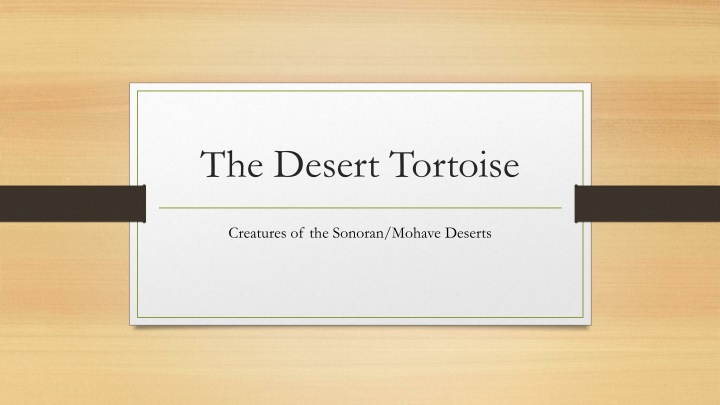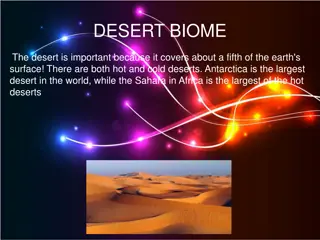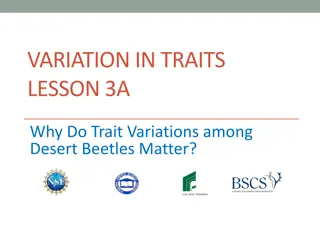The Amazing Desert Tortoise: Surviving Adversity in the Sonoran/Mohave Deserts
The desert tortoise, a fascinating creature of the Sonoran/Mohave Deserts, adapts to its harsh environment by hibernating, foraging on cacti and grasses, and obtaining water from its food. This resilient herbivore has a low reproductive rate and faces many predators but can live up to 50 years. Explore its survival strategies and unique lifestyle in this intriguing ecosystem.
Download Presentation

Please find below an Image/Link to download the presentation.
The content on the website is provided AS IS for your information and personal use only. It may not be sold, licensed, or shared on other websites without obtaining consent from the author.If you encounter any issues during the download, it is possible that the publisher has removed the file from their server.
You are allowed to download the files provided on this website for personal or commercial use, subject to the condition that they are used lawfully. All files are the property of their respective owners.
The content on the website is provided AS IS for your information and personal use only. It may not be sold, licensed, or shared on other websites without obtaining consent from the author.
E N D
Presentation Transcript
The Desert Tortoise Creatures of the Sonoran/Mohave Deserts
The Desert Tortoise This tortoise was one of two I found foraging during a hike on the Tanque Verde Ridge trail, on the Rincorn Mountains, Tucson, Arizona. Normally they are extremely difficult to find during the day! They spend up to 95% of their life underground.
The Desert Tortoise They hibernate from November to March in a burrow or at the base of a brush. During this hibernation the body metabolism slows and its temperature drops.
The Desert Tortoise The female lays her eggs, up to fourteen, between Mid-April to early June. The odds for survival are small, since the small hatchlings have many predators, including foxes, badgers, coyotes, ravens and roadrunners. This tortoise has just been eating a prickly pear from a cactus.
The Desert Tortoise The Heat is On: Desert Tortoises and Survival (Full video)
The Desert Tortoise The desert tortoise manages to survive harsh desert conditions by adapting to its environment. They can live up to 50 years. They eat leaves, cacti and grasses on rocky well-vegetated slopes and washes.
The Desert Tortoise The desert tortoise is a herbivore. It eats mainly grasses, but it also eats herbs, annual wildflowers, and new growth of cacti and their fruit and flowers.
The Desert Tortoise They obtain all the water they need from their food, but they will drink if water is available. In the Sonoran Desert, the summer 'monsoon' season provides a welcome drench from the hot dry conditions where the temperatures regularly exceed 40 C .
The Desert Tortoise Desert tortoises grow slowly and they and have low reproductive rates. Desert tortoises spend much of their time in burrows or rock shelters, in order to regulate body temperature and reduce water loss. They are most active after seasonal rains.
The Desert Tortoise Desert tortoise populations in some areas have been reduced by as much as 90% since the 1980s. Threats to tortoises include urbanization, disease, and habitat destruction. Other threats include illegal collection by humans, and habitat changes as a result of invasive plant species It is unlawful to touch, harm, harass, or collect wild desert tortoises.
The Desert Tortoise The Desert Tortoise s Life (Video)























